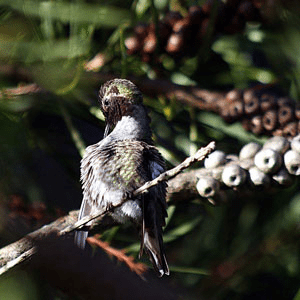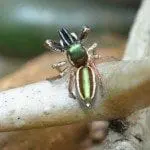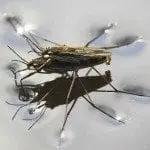This is the pre-publication version which was subsequently revised to appear in Creation 31(1):20–21.
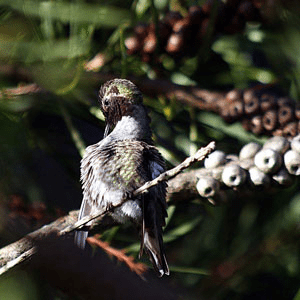
Reading the science news section in my newspaper I was particularly struck by a key feature in common between two separate articles, published side by side, one about the humble starling1 and the other about a more exotic species of hummingbird.2 In both cases, it was reported how fascinating new research efforts have enhanced our understanding of the behaviour of these very different birds. Stories like these illustrate how different starting assumptions may lead to completely different scientific models or understanding—something that is also especially relevant to the origins debate.
An amazing tail’s secret is disclosed
Researchers at the University of California, Berkeley, studied the high-frequency chirping noises made by males of a species called Anna’s hummingbird. They found that these chirps did not come from the head end, as assumed previously, but from the tail end. In fact, this bird makes these loud sounds by super-quick movements of its tail feathers (too fast for humans to see with the naked eye), something not observed in any bird before.3
Naturally, the researchers interpreted this hummingbird study within their evolutionary worldview: ‘The team says smaller birds may have evolved these ways of making more macho sounds because of the limitations of their little “song box” or syrinx.’ In scientific terms this is called an unsubstantiated hypothesis. It assumes (without evidence) that the females of these birds’ ancestors would have been more attracted to louder (‘macho’?) noises than to standard chirps, creating a selection pressure for this mechanism. Furthermore, it is assumes that their voice boxes were somehow limited, ‘encouraging’ males to develop this sophisticated sound-production behaviour using their tails instead! Proper scientific hypotheses need to be tested, but it’s hard to see how this one could be, so it’s little more than ‘just-so’ story-telling (after Rudyard Kipling). They don’t even consider that these hummingbird features could have been created.
One important question that the researchers could have asked in order to explore their ‘macho’ idea is: Is this species of hummingbird the only species where the male chirps with its tail feathers? If so, and considering that all hummingbirds are likely to have derived from one original created kind (baramin), then this would have supported their idea that tail-chirping developed naturally over time. But if tail chirping is common in different species of male hummingbirds then it would seem that the ability was present with the original hummingbirds, and that some species have lost it. That would point to tail singing being a design feature that was specifically created for the first male hummingbird.
The scientists have discovered remarkable evidence that indicates the anatomical and behavioural features are just right for making these sounds. The trailing vane (a sheet of interconnecting hooks and barbules4) of each tail feather flutters up and down and the 4kHz sound is only produced if a travelling wave moves the entire length of the feather (base to tip or tip to base). In ingenious experiments, the researchers investigated the response of feathers in jets of air using high speed video (up to 20,000 frames per second). Manually separating some of the barbs, so upsetting the continuous sheet, disrupted the feathers’ ability to make the sound—this could be restored simply by reconnecting the barbs, so restoring the wave synchrony.
Furthermore, there is no evidence to justify the idea that hummingbirds evolved from anything other than hummingbirds. Consistent with this the ‘earliest’ hummingbird fossils look ‘strikingly similar’ to those that we find today.5 And bird feathers show many hallmarks of ingenious design that defy evolutionary notions of their origins (see Bird evolution flies out the window).
Starlings are experts at sticking together
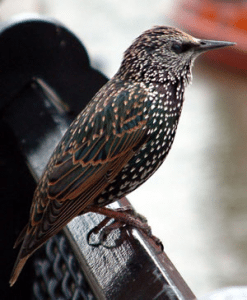
Watching a large flock of birds banking, rolling, turning, twisting and continually morphing into different shapes in flight can be a mesmerizing experience; a similar phenomenon occurs in very large herds of mammals and in schools of fish. It is why such displays are rated by nature lovers the world over to be among the greatest of wildlife spectacles. Due to their sheer numbers, starlings form some of the more impressive aerial displays among birds. But how do they fly in such an impressively cohesive group? The starling project was the combined effort of several European researchers.6 They examined large flocks of the birds in the skies above Rome to investigate how they stick together and move in unison, almost like a super-organism.
Until now, the received wisdom has been that each bird simply keeps a set distance from its near neighbours. But it turns out that this assumption is quite wrong,7 as admitted by the researchers themselves. Instead, the dozen researchers (including biologists, physicists and statisticians) have reached a startling conclusion based on extensive analysis of the three-dimensional positions of several thousand individual birds in the flock: each starling seems to be continuously monitoring the positions of an average of six or seven of its neighbours, regardless of how far away they are. In other words, starlings have a pre-programmed, numeric, object-tracking ability. In their published paper, the authors explain how this tracking method enables the flock to resist the attempts of predators to pick off stragglers because, ‘By interacting within a fixed number of individuals the aggregation can be either dense or sparse, change shape, fluctuate and even split, yet maintain the same degree of cohesion.’8 No wonder that the team members have admitted that these starlings are much cleverer than they had given them credit for—certainly not the first time that scientists have been bemused by brilliant bird brains!9
Starling flock aerobatics over Rome in November 2008.
Wrong assumptions confounded by new evidence
No wonder that the team members have admitted that these starlings are much cleverer than they had given them credit for—certainly not the first time that scientists have been bemused by brilliant bird brains!
In both of the reports discussed here, incorrect beliefs or assumptions (albeit reasonable ones) meant that scientists had been barking up the wrong tree—or in the case of Anna’s hummingbird, examining the wrong end! In the realm of ultimate origins too, we see how starting assumptions (or worldviews) shape people’s perceptions of the world around them. Faced with yet more remarkable insights into the way animals work and behave, we must surely concede that this is overwhelming evidence for a wonderful Creator who conceived, planned, programmed and made them. Then again, those who choose to base their understanding of the natural world on the premise that God doesn’t exist must conclude that everything made itself. Ask yourself: is it scientific to believe that the exquisite design of starling flocking behaviour and hummingbird communication is merely the consequence of Father Time, Mother Nature and Lady Luck? And if not, isn’t it high time that your more fundamental beliefs and assumptions were overturned too?
To accept the Bible’s framework of history (another assumption but a reasonable one10) is to open the door on a new vista of understanding, one which culminates in the realization that human beings were made in God’s image. Of course, we must acknowledge that, through sin, we fall woefully short of His intended perfection. Those who have come (by genuine repentance and faith) to know the Lord Jesus Christ as their Sovereign and Saviour can be confident that their beliefs are well founded—they will not be overturned!
1.Highfield, R., Secret of how these birds of a feather stick together, The Daily Telegraph, 30 January 2008, p. 3.
2.Highfield R., The clever hummingbird uses his tail to serenade mates, The Daily Telegraph, 30 January 2008, p. 3.
3.Clark, C.J. and Feo, T.J., The Anna’s hummingbird chirps with its tail: a new mechanism of sonation in birds, Proc. R. Soc. B, published online, 29 January 2008.
4.For an explanation of how feather structure is a problem for evolution, see Chapter 4, Bird Evolution, of: Sarfati, J., Refuting Evolution, Master Books, 1999, pp. 64–67. Also at: /article/3833/.
5.Oldest hummingbird fossils found, BBC News online, 6 May 2004, accessed 18 February 2008.
6.Ballerini, M. et al., Interaction ruling animal collective behavior depends on topological rather than metric distance: Evidence from a field study, Proc. Natl Acad. Sci. USA 105(4):1232–1237, 29 January 2008.
7.Strictly speaking, this is termed the metric distance whereas the research demonstrates that the birds ‘compute’ the topological distance (interactions) with other birds, as discussed in this article.
8.Ballerini et al., ref. 6, p. 1235.
9.For example, see Sarfati, J., Fancy flying from advanced aeronautics, Creation 29(1):37–39, December 2006; Catchpoole, D., Wings on the wind, Creation 23(4):16–23, September 2001; and Jaroncyk, R., Parrot prodigy, 7 March 2007.
10.See Sarfati, J., Loving God with all your mind: Logic and creation, Journal of Creation (formerly TJ) 12(2):142–151, 1998.

